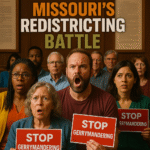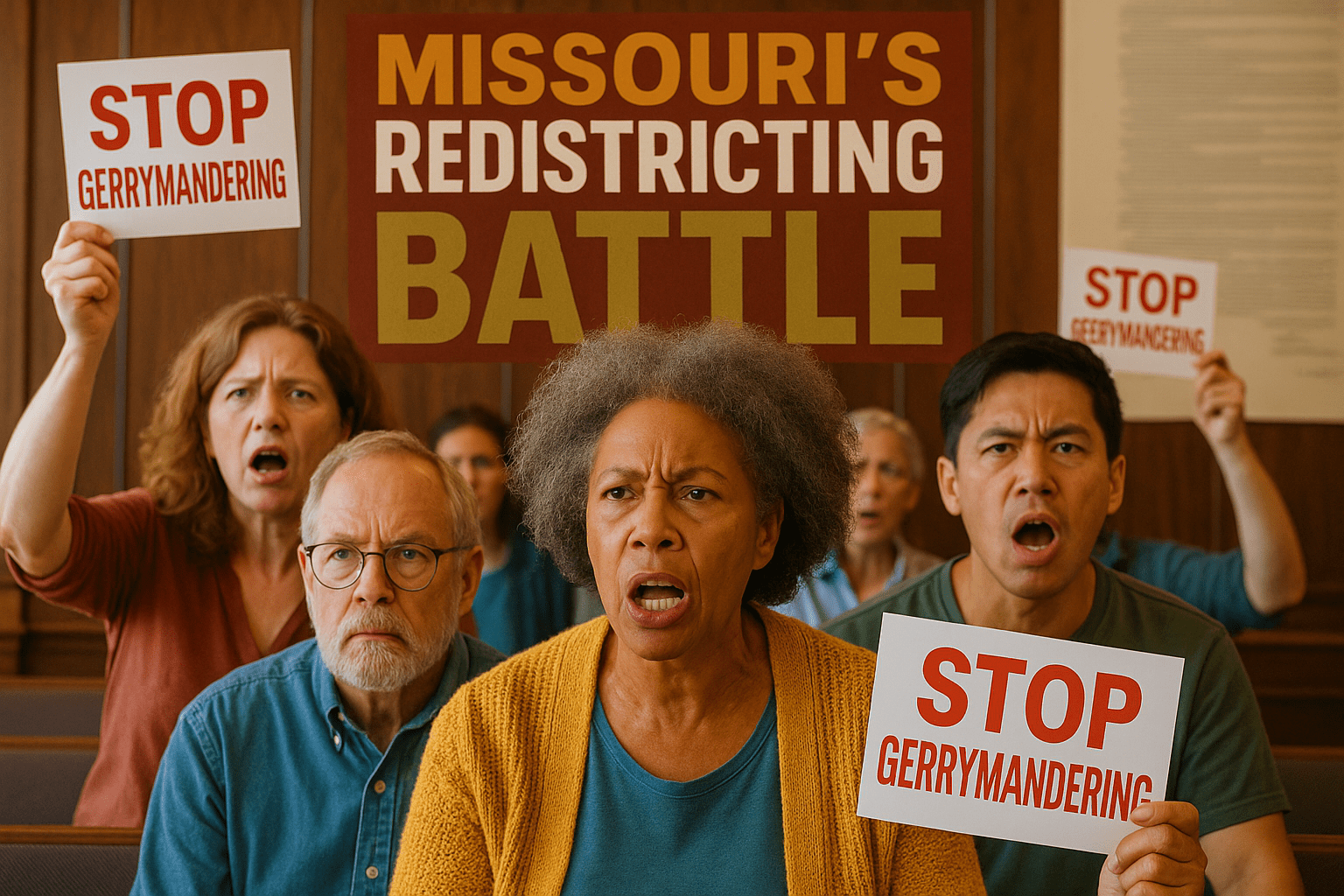

Missouri's Redistricting Battle
By Darius Spearman (africanelements)
Support African Elements at patreon.com/africanelements and hear recent news in a single playlist. Additionally, you can gain early access to ad-free video content.
Gerrymandering Explained
Gerrymandering is a tricky word, but it is important to understand. It is the practice of drawing electoral district boundaries in a way that gives one political party an unfair advantage over another. This can be done by concentrating voters from one party into a few districts, which minimizes their overall impact. Alternatively, it can involve spreading a party's voters across many districts to ensure they win a majority in each one. This manipulation of district lines can significantly impact who gets elected and, therefore, what laws get passed.
In Missouri, the debate over how to divide the state's eight U.S. House districts has been intense. Conservative Republicans have openly pushed for an aggressive map that could flip a Democratic-held seat to the GOP (ktlo.com). This openness about partisan gerrymandering is a shift from previous cycles when such intentions were more discreet. A 2019 U.S. Supreme Court decision, which stated that federal courts have no role in resolving disputes over partisan gerrymandering, has emboldened some Missouri Republicans (ktlo.com). This decision essentially gave state legislatures more freedom to draw maps that favor their party, leading to more aggressive tactics.
The Missouri Map Shift
Missouri House Republicans have approved a new congressional map that aims to change the state's Republican majority in the House from 6-2 to 7-1 (newsone.com). This proposed map seeks to achieve this by dividing the district currently represented by U.S. Rep. Emanuel Cleaver. His district's voters would be split into three Republican-leaning districts (newsone.com). This move has drawn strong criticism from Democrats and public interest groups.
Rep. Cleaver has publicly stated his intention to challenge the new map in court (newsone.com). House Minority Leader Ashley Aune, a Kansas City Democrat, has also criticized the effort, calling it an aid to “the systematic destruction of our democracy” (newsone.com). However, State GOP Rep. Dirk Deaton, the bill's sponsor, defended the map as a “Missouri First map, made in Missouri, for Missouri” (newsone.com). He believes it better represents the state's interests, despite the controversy.
Public Opinion on Redistricting
Missouri Voter Opposition to Redistricting
The redistricting effort in Missouri faces significant public opposition. A recent poll indicates that nearly half of Missouri voters oppose the redistricting effort, viewing it as a waste of resources (newsone.com). This suggests a disconnect between the actions of the state legislature and the desires of the people they represent.
During a public hearing, many Missouri voters spoke out against the new map. A common argument was that it places rural and urban voters with little in common into the same district (newsone.com). A former Republican state legislator, Shannon Cooper, noted the lack of public input in the current redistricting process compared to past efforts. In previous cycles, committees traveled across the state to gather local input (democraticredistricting.com). One St. Louis voter commented that “the idea with democracy is that there’s balance, and if there’s too much of either side that hurts the idea of balance” (democraticredistricting.com). This highlights the concern that the new map disrupts the democratic balance.
Initiative Petition Process Under Threat
In addition to redistricting, Missouri Republicans are advancing legislation that would make it significantly harder for citizens to pass constitutional amendments or state laws through initiative petitions. The initiative petition process allows citizens to propose and enact laws or constitutional amendments directly. This is a powerful tool for voters to influence state policy, and the proposed changes could severely limit their ability to do so.
The proposed legislation, sponsored by State Rep. Ed Lewis, would require a majority of voters in all eight of Missouri’s congressional districts, in addition to a statewide majority, for a constitutional amendment or state law to pass (joplinglobe.com). Under this proposed change, as few as 5% of Missouri voters could effectively defeat a ballot initiative (newsone.com). This legislation largely mirrors a request from Gov. Mike Kehoe (joplinglobe.com). The motivation for this change is partly attributed to the successful abortion rights amendment, which passed with just under 52% of the vote but was opposed in all but eight of Missouri’s 115 counties (komu.com). Representative Lewis argued that the current process “disenfranchises rural Missouri because it does not require ‘broad geographic support,'” stating that “Every last inch of the state of Missouri needs to be represented when we are changing the constitution” (komu.com).
Impact on Voters and Communities
The redistricting and legislative changes in Missouri are likely to significantly affect voters' representation and their ability to influence state and federal policies. By altering the competitive nature of elections, these changes can make it harder for citizens to directly enact laws. For example, the bill limiting court involvement with ballot language for initiatives could make it more difficult for citizens to challenge potentially biased descriptions of proposed laws (stlpr.org).
The new legislation also grants the attorney general the power to appeal preliminary injunctions on ongoing cases related to ballot language. This could potentially delay or hinder challenges to the wording of initiatives (stlpr.org). The Secretary of State's office will have multiple attempts to draft “sufficient and fair” ballot language. Only after three failed attempts can the court propose its own language. This potentially gives state officials more control over how initiatives are presented to voters (stlpr.org). The open pursuit of partisan gerrymandering by some Missouri Republicans aims to bend district boundaries to secure as many seats as possible for their party. This directly impacts the fairness of voter representation (ktlo.com).
A National Trend in Redistricting
Missouri's redistricting efforts are part of a broader national trend of Republican-led states attempting to redraw electoral maps. This trend reportedly began in July when President Donald Trump encouraged Texas Gov. Greg Abbott to consider drawing a new congressional map (newsone.com). This practice has implications for federal elections by potentially altering the balance of power in the U.S. House of Representatives.
In Texas, Governor Abbott called a special legislative session for redistricting, despite devastating floods. This led to a new map that added five seats in districts Trump won by double digits in the 2024 election (newsone.com). Texas Democrats resisted these efforts through filibusters and by leaving the state to deny quorum (newsone.com). Other states, including Ohio and Florida, are also engaged in redrawing electoral maps (newsone.com). The prolonged debate in Missouri's Senate over congressional districts mirrors similar actions in numerous other states (ktlo.com). States like Illinois, Maryland, and New York have drawn district lines to give Democrats an advantage, while states such as Tennessee, Ohio, and North Carolina have done so to benefit Republicans (ktlo.com). Courts have overturned the maps in Ohio and North Carolina, indicating ongoing legal challenges to partisan gerrymandering across the country (ktlo.com).
Countering the Trend
California Governor Gavin Newsom announced the “Election Rigging Response Act” to counter these moves. He proposed a special election to decide whether control of the state's congressional maps will remain with an independent redistricting committee or shift to the state legislature (newsone.com). This highlights the ongoing battle between those who seek to manipulate electoral maps for partisan gain and those who advocate for fairer processes.
The Missouri legislature's bill limiting court involvement with ballot language for initiatives suggests that legislative action can also impact the fairness of the electoral process. This could potentially make it harder for citizens to challenge perceived unfairness (stlpr.org). The current redistricting effort in Missouri is marked by a more open and aggressive pursuit of partisan advantage compared to some previous cycles (ktlo.com). This openness has been emboldened by a 2019 U.S. Supreme Court decision that stated federal courts had no role in settling disputes over partisan gerrymandering (ktlo.com). The fight for fair representation continues across the nation.
The Stakes for African American Voters
Impact on African American Voters
The proposed redistricting in Missouri, particularly the division of U.S. Rep. Emanuel Cleaver's district, has significant implications for African American voters and communities. When districts are carved up, it can dilute the voting power of specific demographic groups, making it harder for them to elect representatives who truly reflect their interests and concerns. This is a classic tactic in gerrymandering, designed to minimize the influence of certain populations.
For African American communities, this can mean a reduction in their ability to shape policy and ensure their voices are heard in both state and federal government. The changes to the initiative petition process also add another layer of challenge. If it becomes harder to pass citizen-led laws, it can limit the avenues through which African American voters can advocate for issues important to their communities, such as civil rights, economic justice, and educational equity. These efforts, when viewed collectively, contribute to a broader trend of suppressing minority votes and representation, which ultimately undermines the principles of a fair and inclusive democracy.
ABOUT THE AUTHOR
Darius Spearman has been a professor of Black Studies at San Diego City College since 2007. He is the author of several books, including Between The Color Lines: A History of African Americans on the California Frontier Through 1890. You can visit Darius online at africanelements.org.
